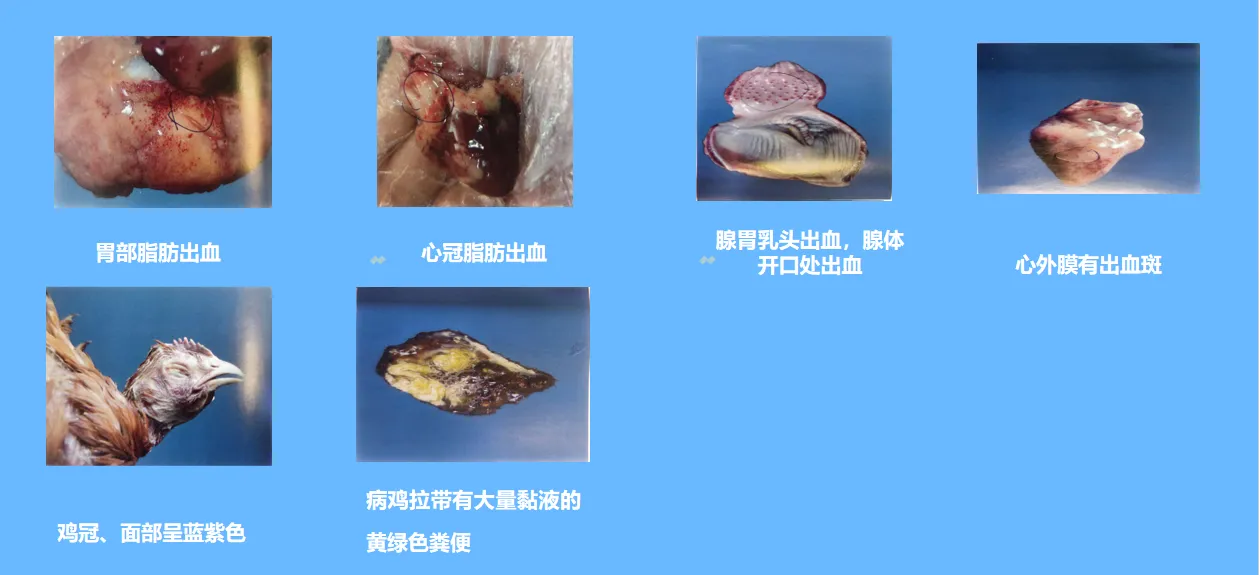Most sick chickens have dark red bloody secretions flowing out of their mouths, eyes, and nostrils before death. Severe diarrhea, white or light yellow or yellow-green loose feces, feathers near the anus are stuck with feces, the crown and wattles are bruised and swollen, the head and neck and subcutaneous edema, and local necrosis. Sinus swelling, increased nasal secretions, runny nose, mouth breathing, coughing, etc. Tears, conjunctival flushing, congestion, bleeding, corneal turbidity, etc. There is bleeding under the scales of the tarsal joints and tibia, and symptoms such as movement disorders, tremors, twisted neck, and opisthotonos appear.

(2) Pathological changes
The pathological changes of highly pathogenic avian influenza (HPAI) and low pathogenic avian influenza (LPA) are not significantly different, and the main characteristics are edema, hemorrhage and necrosis of visceral tissues, organs, serosa, mucosa and skin to varying degrees.
Swelling and bleeding spots on the head, face, neck and toes, hemorrhage, necrosis and cyanosis under the scales of the crown and beard and feet. Gel-like infiltration or yellow cheese-like substances can be seen under the skin when the swollen part of the head and neck is cut open. The conjunctiva of the eyes is congested and hemorrhaged, and there is cheese-like substance in the infraorbital sinus.
The nasal mucosa is congested, hemorrhaged and edematous, the nasal mucus increases, and the nasal cavity is filled with bloody viscous secretions. The laryngeal and tracheal mucosa are congested and hemorrhaged, with a large amount of viscous secretions. In severe cases, the trachea is blocked by yellow cheese-like substances (commonly known as bronchial obstruction). The lungs are edematous, hemorrhaged, and necrotic, purple-black (commonly known as black heart and lungs), and a large amount of foamy liquid flows out of the cut surface. The air sac wall is thickened, turbid, and even necrotic. The thymus is hemorrhagic and atrophic; the spleen is enlarged, congested, and effusive, with needle-tip-sized necrotic foci on the surface, bursal bleeding, serosal edema: the pancreas has yellow-white necrotic spots or hemorrhagic spots, pancreatic edge bleeding, pancreatic degeneration, etc.
Pericardial effusion, endocardial bleeding, myocardial bleeding spots and hemorrhagic spots, myocardial gray or cord-like necrosis; the liver is enlarged, hemorrhagic, brittle, and earthy yellow; the kidneys are enlarged.
Bleeding, piebald.
Abdominal fat, coronary fat, mesenteric fat, stomach fat, subkeel fat, and fat in the four corners of the inner side of the leg muscle have punctate hemorrhages.
The sternal synovial bursa tissue is yellow jelly-like, and there is creamy milky white inflammatory exudate attached to the peritoneum. The glandular stomach is swollen, the glandular stomach papilla is edematous and bleeding, and there is purulent secretion inside; the stratum corneum of the muscular stomach is ulcerated, and there is bleeding under the stratum corneum; there are ring-shaped or strip-shaped bleeding in the duodenum and small intestine mucosa, swelling, bleeding, and ulceration of the cecal tonsils, and congestion and bleeding of the rectum and cloaca mucosa. The fallopian tube is edematous or atrophic, with white purulent secretions or cheesy substances inside, the follicle membrane is severely congested and has large hemorrhage spots, the follicle is deformed, bleeding, liquefied, and purple grape-like, and there is yolk peritonitis, etc.
In some cases, the skull parietal bones and meninges are severely hemorrhaged or punctate, and the brain tissue has gray-white necrotic foci of varying sizes. Due to its relatively long course, low pathogenic avian influenza is often mixed with Escherichia coli disease, chronic respiratory disease, infectious bronchitis, etc., and can easily cause pericarditis, perihepatitis, air sac inflammation, bronchial embolism, black heart and lung, etc.
VITBOO: A new breakthrough in global prevention and control of avian influenza: clinical treatment plan for Chinese herbal feed additives
1.Isatis root (indigotin ≥1.5mg/g, blocking viral replication enzyme activity)
2.Astragalus polysaccharide (immunomodulatory dose 80-120 mg/kg feed, promotes IFN-γ secretion)
3.Houttuynia cordata + cyperus rotundus tea (synergistically reduce lung tissue viral load by 2.7 log10)
VITBOO tailor-made professional technical article framework for avian influenza treatment, integrating the latest scientific research results and transnational application practices, highlighting the therapeutic mechanism and global applicability of Chinese herbal feed additives
Phone:+86-19138056813
Tel:+86-0371-88959050
Email:info@zsybio.com
Address:Zhengzhou City, Henan Province, China